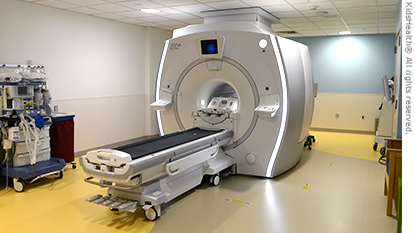PET/MRI Scan
What Is a PET/MRI Scan?
A PET/MRI scan is an imaging test that combines PET (positron emission tomography) and MRI (magnetic resonance imaging) in one session. It creates very detailed pictures of the inside of the body.
Why Is a PET/MRI Scan Done?
PET/MRI scans (also called PET/MR scans) help doctors make a diagnosis and decide on the best treatment for conditions like epilepsy and tumors in the body, including brain tumors. For example, if a child is having seizures that don’t respond to medicines, doctors can do a PET/MRI scan of the brain to see if surgery could help.
How Does a PET/MRI Scanner Work?
A PET/MRI scanner is like two tests in one, a PET scan and an MRI. Combining the PET and MRI studies makes a very detailed 3D image of the body.
For the PET scan, a small amount of a radioactive element (called a tracer) is injected into the blood. The tracer goes to different areas of the body, depending upon how much energy is needed. For example, if doctors want to know where seizures are happening in the brain, they use a glucose (sugar) tracer. The brain uses more glucose in the area where a seizure happens. So the tracer would go to this area if a seizure happens during the scan.
The MRI uses magnets to make an image of the body and a picture of the area being scanned.
How Should We Prepare for a PET/MRI Scan?
Follow these instructions along with any others given to you by your doctor:
For 24 hours before the scan, make sure your child:
- doesn’t eat too many carbohydrates (e.g., bread, pasta, potatoes, cereal, rice)
- avoids caffeine (e.g., chocolate, tea, coffee, sodas) and juice
- limits strenuous activity or exercise
Don’t let your child eat or drink for 6 hours before the scan (water is OK).
For babies:
- no milk/formula for 6 hours before the scan
- no breast milk for 4 hours before the scan
- water is OK
Be sure your child does not wear jewelry, hairpins, or clothing with metal (zippers, buttons, etc.) during the scan.
What Happens Before a PET/MRI Scan?
Children with epilepsy will need an EEG during the first part of the PET scan. Before the scan, the technician will check your child’s blood sugar level and inject the tracer through an IV line (a tiny tube inserted in a vein).

Your child will rest quietly for up to 45 minutes to allow the tracer to settle in the body. The EEG will be running at that time. Then your child is placed in the PET/MRI scanner.
Babies and young children are sedated during a PET/MRI scan. This means they’re given medicine to calm them and let them sleep. Your child’s heartbeat, breathing, and oxygen levels will be checked the whole time they’re sedated.
What Happens During a PET/MRI Scan?
During the scan, your child will lie flat on a table that moves in and out of a doughnut-shaped MRI machine. For a PET/MRI scan of the brain, your child’s head will rest inside a plastic coil (which resembles a round laundry basket).
A contrast solution might be injected in the IV line during the exam to show certain details. The machine makes loud knocking and buzzing noises during the study. Your child might be able to wear headphones and listen to music.
How Long Does a PET/MRI Scan Take?
The entire procedure usually lasts 2–3 hours. The PET/MRI scan itself takes about an hour, depending on the number of scans your doctor ordered. Your child may need extra recovery time after sedation.
What Happens After the PET/MRI Scan?
After the scan, unless told otherwise, your child can return to their normal activities and diet. Most sedation wears off within 1–2 hours. Your child shouldn’t feel any effects from the radiotracer or contrast material, which will pass through the body within 12–24 hours.
A radiologist (a doctor trained in medical imaging) will look at the pictures made by the PET/MRI scan. Your doctor will share the results with you.
Are There Any Risks From a PET/MRI Scan?
A PET/MRI scan is a safe test. There’s no radiation from the MRI because no X-rays are used. Large amounts of radioactivity can be dangerous, but the amount used in a PET scan is very small, about the same as from flying cross-country three times.
There is a very small risk of an allergic reaction to the contrast or a bad reaction to the medicine used in sedation.
How Can I Help My Child?
Before the scan:
- Explain what will happen during the test. Tell your child the test is painless except for a pinch for the IV line.
- Tell your child it’s normal for the machine to make knocking and buzzing noises.
- Have your child bring a favorite blanket for comfort and in case it’s cold during the scan.
After the scan:
- Make sure your child drinks lots of fluids for a day. This will help clear the radioactive tracer and contrast (if given) from the body.
